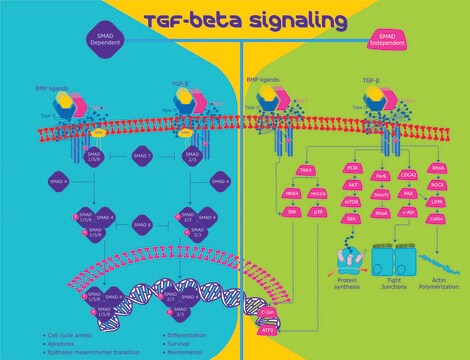L3408
Transforming Growth Factor-β1 Latency Associated Peptide human
≥97% (SDS-PAGE), recombinant, expressed in Sf21 cells, lyophilized powder, suitable for cell culture
Synonym(s):
LAP, TGF-β1
Sign Into View Organizational & Contract Pricing
All Photos(1)
About This Item
Recommended Products
recombinant
expressed in Sf21 cells
Quality Level
Assay
≥97% (SDS-PAGE)
form
lyophilized powder
mol wt
protein 70 kDa
technique(s)
cell culture | mammalian: suitable
impurities
endotoxin, tested
UniProt accession no.
storage temp.
−20°C
Gene Information
human ... TGFB1(7040)
General description
TGF-β is released from degranulating platelets and secreted from nearly all cells in a biologically inactive complex which is unable to bind to cellular receptors and is not recognized by antibodies to TGF-β. The peptide can be activated by acidification, alkalinization, or action of chaotropic agents in vitro. The complex consists of TGF-β associated non-covalently with a protein designated as the latency associated peptide (LAP). TGF-β and LAP represent components of a pro-peptide that is cleaved in a post-golgi compartment prior to secretion. The recombinant human LAP is produced from a DNA sequence corresponding to the 278 amino acid residues of pre-pro-TGF-β1 terminating prior to the mature TGF-β1. LAP contains a Cys33 to Ser33 substitution. LAP contains 249 amino acids, generated after cleavage of a 29 amino acid residue signal peptide. LAP is a glycoslyated, disulfide linked homodimer.
Application
Latency Associated Peptide (LAP) may be used to inhibit transforming growth factor-β 1 activity in various biological systems.
Biochem/physiol Actions
TGF-β1 is produced by many cell types, but is reported to be most concentrated in mammalian platelets, where it is present at approximately four times the level of TGF-β2.
Physical form
Lyophilized from 0.2 μm filtered phosphate buffered saline containing 1.25 mg bovine serum albumin.
Analysis Note
The biological activity is measured by its ability to inhibit TGF-β1 activity on mouse HT-2 cells.
Disclaimer
Unless otherwise stated in our catalog or other company documentation accompanying the product(s), our products are intended for research use only and are not to be used for any other purpose, which includes but is not limited to, unauthorized commercial uses, in vitro diagnostic uses, ex vivo or in vivo therapeutic uses or any type of consumption or application to humans or animals.
Storage Class Code
11 - Combustible Solids
WGK
WGK 3
Flash Point(F)
Not applicable
Flash Point(C)
Not applicable
Personal Protective Equipment
dust mask type N95 (US), Eyeshields, Gloves
Certificates of Analysis (COA)
Search for Certificates of Analysis (COA) by entering the products Lot/Batch Number. Lot and Batch Numbers can be found on a product’s label following the words ‘Lot’ or ‘Batch’.
Already Own This Product?
Find documentation for the products that you have recently purchased in the Document Library.
Muge Sarper et al.
Breast cancer research : BCR, 19(1), 33-33 (2017-03-24)
Normal myoepithelial cells (MECs) play an important tumour-suppressor role in the breast but display an altered phenotype in ductal carcinoma in situ (DCIS), gaining tumour-promoter functions. Matrix metalloproteinase-8 (MMP-8) is expressed by normal MECs but is lost in DCIS. This
Our team of scientists has experience in all areas of research including Life Science, Material Science, Chemical Synthesis, Chromatography, Analytical and many others.
Contact Technical Service



